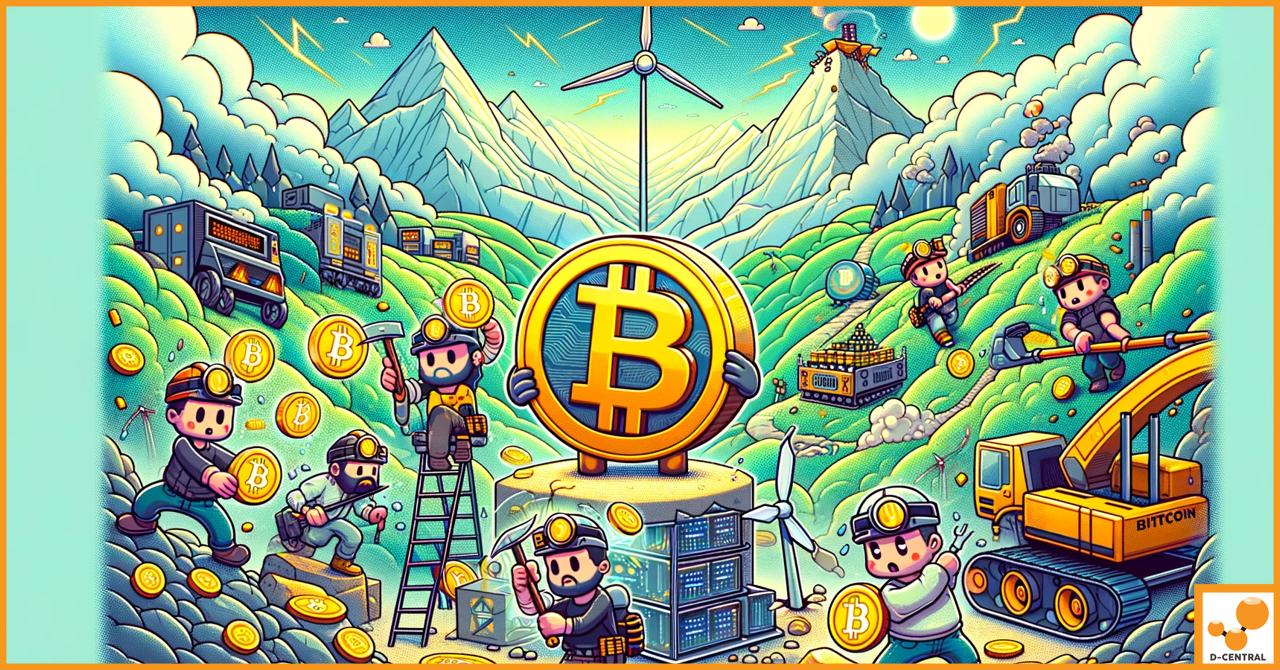
Comprehensive Guide to Bitcoin’s Deflationary Nature and Its Multifaceted Benefits
In the ever-evolving landscape of global finance, Bitcoin emerges as a revolutionary force, challenging traditional monetary systems and redefining the
4479 Desserte Nord Autoroute 440, Laval, QC H7P 6E2

Bitcoin mining, the process by which new bitcoins are introduced into circulation and transactions are verified and added to the public ledger (the blockchain), is foundational to the cryptocurrency ecosystem. This computational endeavor, requiring significant electrical power and sophisticated hardware, is not just about creating new coins. It’s also crucial for maintaining and developing the blockchain, making it a cornerstone of the Bitcoin network’s security and integrity.
However, the path of a Bitcoin miner is fraught with challenges, often referred to as “hard times.” These difficulties range from the inherent market volatility of Bitcoin, with prices fluctuating wildly in short periods, to regulatory pressures from governments and financial institutions that vary significantly across different jurisdictions. Additionally, Bitcoin miners must navigate the halving events—pre-programmed points in the network’s lifecycle that halve the rewards for mining, occurring approximately every four years. Each halving event reduces the rate at which new coins are generated, significantly impacting miners’ profitability and shaking up the mining landscape.
Despite these formidable challenges, hardcore Bitcoin miners have demonstrated remarkable resilience and adaptability. Through a combination of strategic planning, technological innovation, and operational efficiency, they manage not only to survive but also to thrive. These miners, often seen as the backbone of the Bitcoin network, employ various strategies to mitigate the risks associated with market volatility, navigate the complex web of global regulations, and adjust to the economic shifts precipitated by halving events. This article explores how, even when faced with the toughest of times, the most dedicated and innovative miners continue to secure the blockchain, ensuring the stability and growth of the Bitcoin ecosystem.
The journey of a Bitcoin miner is fraught with uncertainties and obstacles that test their resilience and adaptability. Among these challenges, market volatility, regulatory hurdles, and the halving events stand out as significant factors that can dramatically influence the profitability and viability of mining operations.
The price of Bitcoin is known for its extreme volatility, with significant price movements often occurring within very short time frames. This volatility directly impacts mining profitability. When the price of Bitcoin rises, the rewards from mining can provide substantial returns over the operational and electricity costs. Conversely, when the price falls, the thin margins on which many miners operate can quickly turn into losses, forcing less efficient miners to pause operations or exit the market entirely.
Real-world examples: During the 2018 cryptocurrency market downturn, Bitcoin’s price plummeted from its all-time high of nearly $20,000 in December 2017 to below $4,000 by the end of 2018. This drastic decrease squeezed mining profits, leading to a significant drop in the network’s hash rate as miners with higher operational costs were forced to shut down their rigs. Another example occurred in early 2020, when the onset of the COVID-19 pandemic caused a sharp market sell-off in March, temporarily reducing mining profitability and leading to a similar hash rate decline.
Bitcoin miners operate in a global landscape where regulatory attitudes towards cryptocurrency mining vary widely. In some regions, miners enjoy low electricity costs, subsidies, or even government support, while in others, they face strict regulations, heavy taxation, or outright bans.
Case studies:
The Bitcoin halving is a predetermined event that occurs every 210,000 blocks, roughly every four years, which halves the reward that miners receive for adding a new block to the blockchain. This mechanism is designed to control the supply of Bitcoin, mimicking the slowing production of precious resources like gold and contributing to Bitcoin’s deflationary nature.
Historical perspective: The first Bitcoin halving in 2012 reduced the block reward from 50 BTC to 25 BTC, the second in 2016 further reduced it to 12.5 BTC, and the most recent halving in 2020 brought it down to 6.25 BTC. Each halving event has been followed by significant fluctuations in Bitcoin’s price and the mining landscape. While the immediate aftermath of halving can challenge miners due to the reduced rewards, historically, these events have been followed by periods of increased Bitcoin prices, which can ultimately benefit miners who maintain efficient operations through the transition.
These challenges—market volatility, regulatory hurdles, and the halving events—shape the Bitcoin mining ecosystem, requiring miners to be not only technologically adept but also strategically savvy to navigate these turbulent waters successfully.
In the face of the challenges outlined, Bitcoin miners have developed a suite of strategies to ensure not only their survival but also their growth within the volatile landscape of cryptocurrency mining. These strategies revolve around enhancing operational efficiency, geographic diversification, and technological adaptation.
Importance of energy efficiency in mining hardware: One of the most critical factors determining the profitability of a Bitcoin mining operation is the energy efficiency of its hardware. As mining involves solving complex mathematical problems, the process consumes a significant amount of electricity. Therefore, miners prioritize hardware that can provide the highest hash rate while using the least amount of power. The evolution of mining hardware, from CPUs to GPUs, and eventually to ASICs (Application-Specific Integrated Circuits), reflects this relentless pursuit of energy efficiency.
Innovative cooling and power solutions to reduce costs: Beyond selecting energy-efficient hardware, miners have also innovated in cooling and power management solutions to further reduce costs. For instance, some operations have turned to immersion cooling systems, where mining equipment is submerged in a non-conductive liquid that dissipates heat more efficiently than air cooling. Others have leveraged renewable energy sources, such as hydroelectric or solar power, to offset electricity costs. These innovations not only improve profitability but also contribute to the sustainability of mining operations.
The strategic relocation of mining operations to regions with lower energy costs and favorable regulations is another vital strategy for miners. By moving to areas where electricity is cheaper and regulatory environments are more supportive, miners can significantly reduce their operational costs and mitigate the risk of adverse legislation.
Examples of successful geographic diversification:
To stay competitive, miners must continuously adapt to the latest mining technologies and rigs. This involves upgrading to more efficient ASIC miners as they become available and exploring software solutions that optimize mining performance.
Custom solutions and modifications for enhanced performance: Beyond off-the-shelf hardware, some mining operations develop custom solutions and modifications to further enhance performance. This can include tweaking ASIC firmware to improve efficiency, custom-building rigs to optimize space and cooling, or developing proprietary mining pool software to reduce latency and improve hash rate distribution.
These strategies—focusing on operational efficiency, geographic diversification, and technological adaptation—enable hardcore Bitcoin miners to navigate the complex and ever-changing landscape of cryptocurrency mining. By continuously optimizing their operations, miners can not only survive the hard times but also position themselves for growth as the Bitcoin ecosystem evolves.
As the Bitcoin mining industry evolves, innovations in renewable energy integration, blockchain technology, and community efforts are setting the stage for a more efficient, transparent, and decentralized future. These advancements not only address the current challenges faced by miners but also pave the way for sustainable growth in the ecosystem.
The integration of renewable energy sources into Bitcoin mining operations is a significant trend, driven by both environmental concerns and the quest for lower operational costs.
Case studies of mining operations utilizing solar, wind, and hydroelectric power:
The environmental and economic benefits of renewable energy in mining: Utilizing renewable energy sources not only helps in reducing the environmental impact of Bitcoin mining but also offers economic benefits by lowering electricity costs, which are a significant portion of a miner’s operational expenses. This shift towards green energy can also improve the public perception of Bitcoin mining, aligning it with global sustainability goals.
Innovations within the blockchain technology itself are also contributing to the efficiency and transparency of mining operations.
Exploration of blockchain innovations aimed at improving mining efficiency and transparency: Innovations such as the implementation of the Stratum V2 protocol aim to enhance the efficiency of the mining process and improve security. This protocol also increases transparency in mining operations, allowing for better coordination and communication between miners and mining pools.
Future technologies on the horizon for Bitcoin mining: Looking ahead, technologies like off-chain settlement layers and improvements in ASIC chip design promise to further optimize mining efficiency. Additionally, the development of more sophisticated mining algorithms and the potential integration of AI and machine learning into mining operations could revolutionize how miners solve blocks and manage their rigs.
The role of mining pools and communities is crucial in supporting individual miners and ensuring the decentralization of the Bitcoin network.
The role of mining pools and communities in supporting individual miners: Mining pools allow individual miners to combine their computational power to compete more effectively for block rewards. These communities also provide a platform for sharing knowledge, strategies, and innovations, helping smaller miners remain competitive.
Efforts towards maintaining decentralization in the Bitcoin network: As the mining industry grows, maintaining the decentralization of the Bitcoin network remains a priority. Initiatives like the development of decentralized mining pools and the encouragement of small, individual miners contribute to a more distributed and resilient network. These efforts ensure that no single entity has too much control over the blockchain, preserving the democratic and decentralized ethos of Bitcoin.
These innovations in renewable energy integration, blockchain technology, and community support are not just shaping the present landscape of Bitcoin mining; they are also laying the foundation for a future where mining is more sustainable, efficient, and inclusive, ensuring the long-term health and security of the Bitcoin network.
The journey of Bitcoin miners is emblematic of resilience and adaptability, qualities that are indispensable in the ever-evolving and challenging landscape of cryptocurrency mining. Throughout this exploration, we’ve seen how hardcore Bitcoin miners navigate through market volatility, regulatory uncertainties, and the inevitable halvings with a blend of innovation, strategic foresight, and an unwavering commitment to their craft. These miners are not merely participants in the cryptocurrency ecosystem; they are its steadfast pillars, ensuring the security, efficiency, and ongoing prosperity of the Bitcoin network.
Innovation and strategic planning emerge as the linchpins in this complex environment. The adoption of renewable energy sources, advancements in blockchain technology, and the fostering of robust mining communities illustrate the multifaceted approach miners must take to remain competitive and sustainable. These strategies are not static; they evolve in response to new challenges and opportunities, reflecting the dynamic nature of the Bitcoin ecosystem itself.
Looking ahead, the future of Bitcoin mining holds both challenges and opportunities. As the industry continues to mature, the ongoing evolution of mining strategies will be crucial for ensuring the survival and prosperity of miners. This evolution will likely be characterized by further integration of green technologies, deeper exploration of blockchain innovations, and a reinforced commitment to decentralization and community support.
For those navigating the complexities of the mining landscape, D-Central Technologies offers a suite of solutions designed to optimize mining operations, reduce costs, and enhance profitability. From cutting-edge mining hardware to strategic consulting services, D-Central is committed to supporting miners in their quest for efficiency and growth.
We invite the mining community to explore the solutions provided by D-Central Technologies and join us in a dialogue about the future of Bitcoin mining. Your feedback, experiences, and discussions are invaluable as we collectively navigate the challenges and seize the opportunities that lie ahead in the cryptocurrency mining landscape. Together, we can ensure that the backbone of the Bitcoin network remains strong and resilient, ready to face whatever the future holds.
What are the main challenges faced by Bitcoin miners?
Bitcoin miners face several challenges, including market volatility affecting Bitcoin prices, regulatory pressures varying across jurisdictions, and halving events that reduce mining rewards, all of which significantly impact profitability and operations.
How do Bitcoin miners navigate market volatility?
Bitcoin miners navigate market volatility through strategic planning, technological innovation, and operational efficiency, adapting their operations to ensure profitability, regardless of Bitcoin price fluctuations.
What is the impact of regulatory hurdles on Bitcoin mining?
Regulatory hurdles can vastly impact Bitcoin mining, with miners operating in a global landscape where policies vary widely—from support and subsidies to heavy taxation and outright bans, influencing where and how miners conduct their operations.
How do halving events affect Bitcoin miners?
Halving events, which occur approximately every four years, reduce the rewards that miners receive for adding new blocks to the blockchain, thereby impacting their profitability. Many miners adapt by enhancing operational efficiencies or banking on eventual price increases post-halving to maintain profitability.
What strategies do miners use to remain competitive?
Miners focus on operational efficiency, geographic diversification to more favorable regions, and technological adaptation, including upgrading to more energy-efficient mining hardware and exploring innovative cooling and power solutions.
What role does renewable energy play in Bitcoin mining?
Renewable energy sources like solar, wind, and hydroelectric power play a significant role in reducing operational costs and environmental impact for Bitcoin mining, contributing to sustainability and improved public perception of the mining process.
How do blockchain innovations contribute to mining efficiency?
Blockchain innovations aim to improve the efficiency and transparency of mining operations through new protocols and technologies, enhancing coordination between miners and pools, optimizing mining performance, and supporting decentralization efforts.
What role do mining pools and communities play in the Bitcoin network?
Mining pools and communities support individual miners by combining computational power for more effective mining, sharing knowledge and strategies, and contributing to the decentralization and resilience of the Bitcoin network.
How does D-Central Technologies support Bitcoin miners?
D-Central Technologies offers solutions to optimize mining operations, reduce costs, and enhance profitability. Their services include mining hardware, strategic consulting, and support aimed at helping miners navigate the complexities of the mining landscape.
DISCLAIMER: D-Central Technologies and its associated content, including this blog, do not serve as financial advisors or official investment advisors. The insights and opinions shared here or by any guests featured in our content are provided purely for informational and educational purposes. Such communications should not be interpreted as financial, investment, legal, tax, or any form of specific advice. We are committed to advancing the knowledge and understanding of Bitcoin and its potential impact on society. However, we urge our community to proceed with caution and informed judgment in all related endeavors.
Related Posts

In the ever-evolving landscape of global finance, Bitcoin emerges as a revolutionary force, challenging traditional monetary systems and redefining the

Bitcoin, the pioneering cryptocurrency, has revolutionized the financial landscape since its inception in 2009. Renowned for its decentralized nature, Bitcoin

In the rapidly evolving world of cryptocurrency mining, Application-Specific Integrated Circuits (ASICs) have emerged as the linchpin of efficiency and